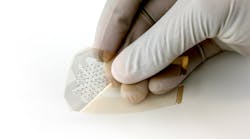A new type of bandage, one designed at the University of California at Berkeley to detect wounds rather than protect them, could help doctors treat and cure bed sores before they break the skin and get infected.
The bandage consists of an array of electrodes printed on a flexible film. A low current sent between the electrodes at various frequencies spreads into the surrounding skin tissues. The bandage then detects and maps the impedance spectrum of the underlying issue.
Healthy skin-cell membranes are relatively impermeable and act as insulators around cells’ conductive contents. This makes the cells act much like capacitors. But when pressure limits the local blood supply, cell membranes break down and let electrical signals leak through, much like a resistor. Impedance spectroscopy detects these changes, which correlate with bed sore formation and can be detected in the early stages of bed-sore formation.
Watch "Smart Bandage Detects Invisible Wounds," courtesy of Engineering TV:
“By the time you see signs of a bed sore on the surface of the skin, it’s usually too late,” said Dr. Michael Harrison, a professor of surgery involved with the project. “This bandage could provide an easy early-warning system that would allow intervention before the injury is permanent. If you can detect bed sores early on, the solution is easy. Just take the pressure off.”
Bed sores affect an estimated 2.5 million people in the United States, cost $2.5 billion annually to treat, and increase a patient’s chances of dying by a factor of 2.8. They mostly affect patients confined to beds or wheelchairs, though increased rates of diabetes and obesity have made bed sores or pressure ulcers more common.
Researchers plan to investigate other diseases and trauma that change the electrical behavior of tissues to see if they can detect those changes in the early stages.
